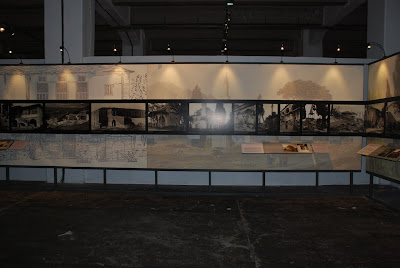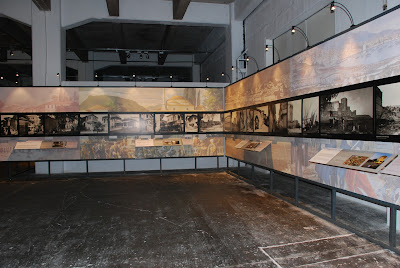
30 July – 19 September 2010
ARTIST
Aristotelis Zachos
«Architectural counterpoints in Greece: from 19th century tradition to 21st century mutations»
The exhibition brings together more than 100 photographs by renowned Greek architect, Aristotelis Zachos (1871 – 1939). The photographs, which belong to the Benaki Museum's Neohellenic Architecture Archives, were chosen because they offer a photographic testimony of an architecture, now forever lost, of great value and interest for both architects and historians, as well as for non-specialists. It is far more than a simple juxtaposition of old photographs as, alongside, depictions of earlier scenes are presented, as well as recent photographs recording the tremendous changes in the urban environment's development and the world vision of today's society.
Architect Yannis Kizis, who planned and curated the exhibition, writes: «Zachos photographs ensembles or details, recording the town, the monument, the fountain, without any artistic intention. Nevertheless, the result has a strange charm, as, almost always, the photographed subject includes people, looks, behaviours and costumes that outline the living conditions of interwar Greece's human mosaic.
The urban landscape is in a constant flux. It is changed by the human groups of each period that reconstruct it, enjoy it or disdain it. At the same time, they have difficulty in realizing the reality they themselves shape and the problems they cause (...)
The counterpoints of the exhibition's images highlight the fact that, in just over half a century since Zachos took these photographs, all the main characteristics have been irrevocably changed, both the architecture and the more general development of its environment...»
The “architectural counterpoints” were first exhibited in 2008 in Volos, the town – port of Thessaly, at the foot of Mount Pelion and the villages that were a rich source of material for Zachos' photographic lens: the mansions of Greek merchants, outstanding specimens of urban architecture in Ottoman times. An architecture that marked the character of the Balkans and Asia Minor, with the empire's capital as the centre of creation and a pole of influence.
In 2009, the exhibition travelled to Thrace, to be shown in what could almost be considered as the photographs' natural habitat, a wooden “koukoulospito” (i.e. a house designed to meet the needs of sericulture); later in the same year, it was shown in Lesvos, the island of the eastern Aegean where one still comes across hamlets with an atmosphere and people with manners of times past.
Seeing the “architectural counterpoints” again at Istanbul 2010, it is natural to compare the evolution of the urban and suburban sites of contemporary Turkey with the corresponding transformations Greece has known.
For many centuries, our countries shared a single architectural culture, with obvious common characteristics as regards the town's picture and the structure of dwellings. The tall courtyard walls, above which the wooden houses' balconies peeked out, traced a labyrinth of narrow streets and alleys. At their crossroads, churches or mosques, fountains or markets marked the nodal points of contact of pre-industrial communities.
The loss of the image of “our Oriental version” of towns, the sacrifice of the 19th century's refined urban landscapes on the altar of 20th century development, is experienced equally painfully in Turkey today. It is not only the buildings and their environment that have been lost. Customs have been lost, while other values have composed new codes of social cohesion, or even of distancing and reorientation. Young people see these old photographs as a picturesque and incomprehensible decor, at the very best with a touch of indeterminate romanticism. Indeed, it would be inconceivable for a modern Zachos to photograph enigmatic faces in Greek mountain villages, nor could Ara Güler encounter the barefoot children playing in muddy puddles among the wooden houses of Zeyrek. Their old photographs, though, might provide us with food for thought.
Born to a prosperous family from Siatista (Western Macedonia), Aristotelis Zachos studied architecture in Germany, where he lived and worked for 17 years. He interrupted his studies in order to fight, as a volunteer, in the war of 1897. He returned to Greece in 1906 to live permanently and to acquaint himself with the works of her people, travelling through the width and breadth of the country to do so and either sketching or photographing them. He sought out the Greek character in Byzantine and traditional architecture of modern times and is considered today as being one of the pioneers of the «return to roots» movement.
Yunanistan’da Mimari Paralellikler: 19. Yüzyıl Geleneğinden
21. Yüzyıl Değişikliğine
Aristotelis Zachos
30 Temmuz-19 Eylül 2010
Piraeus Bank Grup’un Kültür Vakfı (www.piop.gr), her yıl düzenlenen "Avrupa Kültür Başkenti" festivaline, İstanbul’da Sanat Limanı’nda (Antrepo 5), 30 Temmuz ve 19 Eylül 2010 arasında yer alacak iki sergi ile katılıyor (açılış Cuma 30 Temmuz, saat 19.00): "Yunanistan’da mimari paralellikler: 19. yüzyıl geleneğinden 21. yüzyıl değişikliğine" ve ‘’Aramızdaki Mekan’’
"Yunanistan’da mimari paralellikler: 19. yüzyıl geleneğinden 21. yüzyıl değişikliğine"
Sergi, tanınmış Yunan mimar Aristotelis Zahos’un (1871-1939) 100den fazla fotoğrafını içerir. Benaki Müzesinin Yeni Yunan Mimarisi Arşivine ait olan fotoğrafları gerek mimar ve tarihçiler gerekse de uzman olmayanlar için büyük önem taşıyan, ebediyen kaybolmuş bir mimarinin fotoğraflara yansıyan belgeleri olduğu için seçilmişlerdir. Sergi, basit bir eski fotoğraf sergisi değildir; çünkü bunlarla birlikte gerek günümüzdeki toplum anlayışını ve kentsel çevrenin oluşumu bakımından meydana gelen çok büyük değişiklikleri, gerekse de Zahos’tan önceki devrelerin görüntülerini kapsamaktadır.
Sergiyi düzenleyen ve koordine eden mimar Yannis Kizis, bununla ilgili şunları yazar:
"Zahos, bütün veya ayrıntılı detay olarak şehri, anıtı, çeşmeyi sanatsal bir niyeti olmadan görüntüler. Buna rağmen netice olarak tuhaf bir çekicilik belirir, çünkü hemen hemen daima tema içinde, iki dünya harbi arasındaki zaman zarfında Yunan toplumunun hayat şartlarını yansıtan simalar, bakışlar, davranışlar ve giyim-kuşam tarzı yansır.
Kentsel görünüm devamlı olarak değişkenlik gösterir. Her devrin insanları onu değiştirir, yeniden biçimlendirir, onunla iftihar eder veya onu kıymetten düşürür. Aynı anda, kendilerinin biçimlendirdiği gerçek durumu ve sebep oldukları problemleri idrak etmekte zorluk çekerler. (…)
Sergilenen resimlerin uyumluluğu, Zahos’un fotoğraflarını çekmesinden yarım yüzyıllık zaman içinde, gerek mimarinin gerekse de evrensel toplum ortamının genel formasyonunu belirleyen tüm ana unsurları geri dönmemek üzere mi değiştiğini gösterir."
"Mimari Paralellikler" ilk defa 2008 yılında, Zahos’un objektifine zengin tema veren Pilion bölgesi köylerinin altındaki, Tesalya’nın liman kenti olan Volos’ta sergilendi. Bunlar, Osmanlı devri kentsel mimarisinin en seçkin örnekleri olan, Yunan tüccarların konakları idi. Yaratıcı ve müessir merkezi imparatorluğun başkenti olan bu mimari tarzı, Balkanlaşmış Küçük Asya’nın mimari karakterini de topyekün etkiledi.
2009 yılında Trakya’da, hemen hemen tabii ortamları içinde, ahşap bir böceklikte daha sonra da halen başka devirlerin atmosferini taşıyan yerleşme birimleri ve insan ahlakının bulunduğu Doğu Ege denizindeki Lesvos (Midilli) adasında yeniden sergilendi.
"İstanbul 2010"’da "Mimari Paralellikler" sergisini yeniden görünce, tabii olarak güncel Türkiye’nin kentsel ve kent civarı bölgelerinin gelişme süreci ile Yunanistan’da meydana gelen mütekabil değişiklikleri kıyaslama isteği belirir.
Ülkelerimiz birçok yüzyıl boyunca, şehir görünümü ve ev inşa tarzı tabii olarak müşterek karakterler taşıyan ortak bir mimari kültürünün etkisi altında yaşamışlardır. Üzerlerinde ahşap evlerin çıkmalarının belirdiği yüksek avlu duvarları bir sokaklar lâbirenti meydana getirirdi. Kavşak noktalarında kilise veya camiler, çeşmeler veya pazar yerleri endüstri öncesi toplumlarının temas ettikleri noktaları belirtirdi.
Anadolu üslubundaki şehir görünümünün kaybı, 20. yüzyılın gelişme süreci içinde 19. yüzyılın ince ruhlu kentsel çevre görünümünün feda edilmesi, bugün Türkiye’de de aynı derecede acı verici biçimde yaşanmaktadır. Birçok örf ve adet kaybolmuş, başka değerler yeni toplumsal anlayışlar veya yabancılaşma ve yenileme ilkeleri empoze etmişlerdir. Gençler eski fotoğrafları göz alıcı ve anlaşılmaz bir mekân olarak, en iyi durumda ise belirsiz bir romantizm duygusu ile algılamaktadır. Zaten güncel bir Zahos’un yeniden Yunan dağ köylerinde esrarengiz çehreler görüntülemesi akıl dışı bir hareket olacaktı; nasıl ki Ara Güler bile bugün Zeyrek’teki ahşap evler arasında, çamurlu sokaklarda oynayan yalınayak çocuklar bulamaz. Ancak ikisinin de eski fotoğrafları belki bizi tekrar düşünmeye sevk eder.
Siatista’dan zengin bir tüccar ailesinin oğlu olan Aristotelis Zahos Almanya’da mimarlık eğitimi gördü, on yedi yıl orada çalışarak yaşadı, ancak diplomasını alamadı. Talihsiz 1897 Osmanlı-Yunan harbine gönüllü asker olarak katılmak için eğitimine ara verdi. Bir baştan bir başa insanların eserlerini tanımak, resimlemek ve görüntülemek ve kendi mimarisi ile zenginleştirmek için 1906 yılında yerleşmek üzere Yunanistan’a döndü. Bizans ve halk mimarisinde Yunan karakterini aradı ve günümüzde mimari tarzının "eski geleneklere" dönmesinin öncüsü sayılır.



